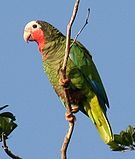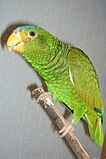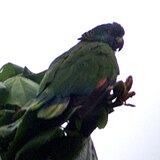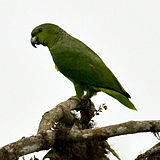List of amazon parrots
The amazon parrots are 33 species of parrots that comprise the genus Amazona. They are native to the New World, ranging from South America to Mexico and the Caribbean. Amazon parrots range in size from medium to large, and have relatively short, rather square tails. They are predominantly green, with accenting colours that are quite vivid in some species.
The taxonomy of the yellow-crowned amazon (Amazona ochrocephala complex) is disputed, with some authorities listing only a single species (A. ochrocephala), and others splitting it into as many as three species (A. ochrocephala, A. auropalliata and A. oratrix).[1][2][3] The yellow-faced parrot, Alipiopsitta xanthops, was traditionally placed within the amazon parrot genus, but recent research has shown that it is more closely related to the short-tailed parrot and species from the genus Pionus; as a result, it has been transferred to the monotypic genus Alipiopsitta.[4][5]
Two extinct species have been postulated, based on limited evidence.[6][7] They are the Martinique amazon (Amazona martinica)[8][9] and the Guadeloupe amazon (Amazona violacea).[6][10][11] Amazon parrots were described living on Guadeloupe by Jean-Baptiste Du Tertre in 1667 and by Jean-Baptiste Labat in 1742, and they were called Psittacus violaceus at that time. Labat also described amazon parrots living on Martinique. There are no specimens or remains of either island population, so their taxonomy may never be fully elucidated. Their status as separate species is unproven and they are regarded as hypothetical extinct species.[6]
In 2017 a study published by ornithologists Tony Silva, Antonio Guzmán, Adam D. Urantówka and Paweł Mackiewicz proposed a new species for the Yucatan Peninsula area (Mexico), being this named blue-winged amazon (Amazona gomezgarzai).[12] However, subsequent studies question its validity, indicating that these organisms possibly had an artificial hybrid origin.[13]
Species
| Common and binomial names[7] | Image | Description | Range |
|---|---|---|---|
| Festive amazon (Amazona festiva) |
 |
Mostly green, red forehead, deep blue outer wing feathers, red rump. | Brazil, Colombia, Bolivia, Ecuador, Guyana, French Guiana, Peru, Venezuela[14][15] |
| Vinaceous-breasted amazon (Amazona vinacea) |
 |
30 cm (12 in) long, mostly green, red forehead, bluish nape, vinous-maroon breast.[16] | Argentina, Brazil, Paraguay[17] |
| Tucumán amazon (Amazona tucumana) |
 |
31 cm (12 in) long, mostly green with feathers of the upper body being green with black margins. Red plumage on the forehead and forecrown, and the red does not extend around the white eye rings. Red primary wing feathers with no red at the bend of the wing. Orange thighs and red at the base of a green tail.[18] | Argentina, Bolivia[19][20] |
| Red-spectacled amazon (Amazona pretrei) |
 |
32 cm (12.5 in) long, mostly green with a variable extent of red on the forehead, lores, and around the eyes. The eye rings are white and the bill is yellowish. Red on the bend of the wings with blue tips to the primary and secondary wing feathers.[21] | Argentina, Brazil, Paraguay[22] |
| Black-billed amazon (Amazona agilis) |
 |
25 cm (10 in) long, mostly green with small patches of red on the wing and sometimes flecked with red on the head, black beak.[23] | Jamaica[24] |
| White-fronted amazon (Amazona albifrons) |
 |
25 cm (10 in) long, mostly green, white forehead with blue on the crown, red on the sides of the face. Sexual dimorphism: males have bright red feathers on their shoulders, while females have green shoulders. | Belize, Costa Rica, El Salvador, Guatemala, Honduras, Mexico, Nicaragua[25][26] |
| Yellow-billed amazon (Amazona collaria) |
 |
28 cm (11 in) long, mostly green, white face markings and white forehead, blue forecrown, pink throat and upper breast, bluish primaries, yellow bill.[27] | Jamaica[28] |
| Cuban amazon or rose-throated amazon (Amazona leucocephala) |
 |
28–33 cm (11–13 in) long, mostly green, white on the face, pink throat, brownish on the belly.[29] | Cuba, the Bahamas, the Cayman Islands[30][31] |
| Hispaniolan amazon (Amazona ventralis) |
 |
28–31 cm (11–12 in) long, mostly green, white forehead, blue flight feathers, maroon belly and red in the tail feathers.[32] | Haiti, the Dominican Republic, Puerto Rico, the U.S. Virgin Islands[33] |
| Puerto Rican amazon (Amazona vittata) |
 |
28–30 cm (11–12 in) long, mostly green, red forehead, white eye rings.[34] | Puerto Rico[35] |
| Lilac-crowned amazon (Amazona finschi) |
 |
30.5–34.5 cm (12–14 in) long, mostly green, maroon forehead, violet-blue crown.[36] | Northwestern to southwestern Mexico[36][37][38] |
| Red-lored amazon (Amazona autumnalis) |
 |
32–35 cm (13 in) long, mostly green, red forehead and, in some subspecies, yellow cheeks (sometimes with red spots), blue crown. | Central and South America[39][40] |
| Lilacine amazon (Amazona autumnalis lilacina) |
 |
The lilacine amazon is a small parrot, approximately 34 cm long when mature, with primarily green plumage. Like the red-lored amazon, it has red lores and yellow cheeks; its distinguishing features include a fully black beak, and lilac-tipped feathers on its crown.[41][42] | Western Ecuador to extreme south-western Colombia.[42] |
| Diademed amazon (Amazona diadema) |
 |
Length of about 33 cm (13 in). Largely green bird with glimpses of red and black; many of the feathers are margined with contrasting colours giving a finely scalloped effect.[43] | Amazon basin in northern Brazil;[43] |
| Red-crowned amazon (Amazona viridigenalis) |
 |
33 cm (13 in) long, mostly green, bright red forehead and crown, dark blue streaks behind the eyes, and light green cheeks. Less red on the crown of the female and the juvenile.[44] | Native to Mexico; introduced to Puerto Rico and the United States[45] |
| Yucatan amazon (Amazona xantholora) |
 |
Mostly green, blue crown and yellow on the sides of the face, horn-coloured (grey) beak. | Belize, Honduras, Mexico[46][47] |
| Blue-cheeked amazon or Dufresne's amazon (Amazona dufresniana) |
 |
34 cm (13.5 in) long, mostly green, blue cheeks. | French Guiana, Guyana, Suriname, Venezuela, possibly in northern Brazil[48][49] |
| Red-browed amazon (Amazona rhodocorytha) |
 |
35 cm (14 in) long, mostly green, red forehead fading to brownish-purple on the crown, orange lores and yellow below the lores, bluish to violet cheeks and throat.[50] | Eastern Brazil[51][52] |
| Red-necked amazon (Amazona arausiaca) |
 |
40 cm (16 in) long, mostly green, blue forehead and face, white bare eye rings, red patch on the throat (sometimes absent).[53] | Dominica[54] |
| Saint Lucia amazon (Amazona versicolor) |
 |
43 cm (17 in) long, mostly green, blue face and forehead, red breast becoming maroon and mottled on the lower breast and belly.[55] | Saint Lucia[56] |
| Yellow-headed amazon (Amazona oratrix) |
 |
35–38 cm (14–15 in) long, mostly green, yellow head.[57] | Belize, Guatemala, Mexico.[58] |
| Yellow-naped amazon (Amazona auropalliata) |
 |
Mostly green, yellow band across the lower nape and hindneck. | Costa Rica, El Salvador, Guatemala, Honduras, Mexico, Nicaragua[59][60] |
| Yellow-crowned amazon (Amazona ochrocephala) |
 |
33–38 cm (13–15 in) long, mostly green, extent of the yellow on the head varies between subspecies. | South America, Panama[61][62] |
| Panama amazon (Amazona ochrocephala panamensis) |
 |
35 centimetres (13.8 in) in length, are bright green with a yellow area on the forehead, and a horn-colored (gray) beak, sometimes with a dark tip, but lacking the reddish coloring on the upper mandible that is present in the nominate yellow-crowned amazon.[63] | Panama (including the Pearl Islands and Coiba) and northwest Colombia.[42][64][7][65] |
| Yellow-shouldered amazon (Amazona barbadensis) |
 |
33 cm (13 in) long, mostly green, white forehead and lores, yellow crown and ear coverts, bare white eye rings. Yellow chin and shoulders. Some red and dark blue in the wing feathers.[66] | The Netherlands Antilles, Venezuela[67] |
| Blue-fronted amazon (Amazona aestiva) |
 |
38 cm (15 in) long, mostly green, blue forehead and yellow on the face. | Bolivia, Brazil, Paraguay, northern Argentina[68][69] |
| Scaly-naped amazon (Amazona mercenarius) |
 |
Mostly green. | Bolivia, Colombia, Ecuador, Peru, Venezuela[70][71] |
| Mealy amazon (Amazona farinosa) |
 |
38–41 cm (15–16 in) long, mostly green, extent of yellow and green on the forehead and crown varies between subspecies. | Mexico, Central and South America[72][73] |
| Kawall's amazon (Amazona kawalli) |
 |
Large and mostly green, white skin at the base of the bill. | Bolivia, Brazil[74][75] |
| Imperial amazon (Amazona imperialis) |
 |
45 cm (18 in) long, mostly green, purple neck, green-tipped red tail and purple below.[76] | Dominica[76] |
| Red-tailed amazon (Amazona brasiliensis) |
 |
37 cm (14.4 in) long, mostly green, red forehead fading to purple on the crown. Blue throat, cheeks and over the ears. Red in the tail feathers.[77] | Southeastern Brazil[51][78] |
| Orange-winged amazon (Amazona amazonica) |
 |
33 cm (13 in) long, mostly green, blue and yellow feathers on the head which varies in extent between individuals. The upper mandible is partly horn-coloured (grey) and partly dark grey. It has orange feathers in the wings and tail. | South America[79][80] |
| Saint Vincent amazon (Amazona guildingii) |
 |
40 cm (16 in) long, mostly green, multi-coloured with a yellowish-white, blue and green head, greenish-bronze upperparts, grey feet, orange irises, and violet blue-green wings and tail feathers. There is a yellow-brown morph and a less common green morph.[81] | The Caribbean island of Saint Vincent in the Lesser Antilles[82] |
See also
References
- ^ Binford, L. (1989). "A distributional survey of the birds of the Mexican state of Oaxaca." Ornithological Monographs. 43: 1–418.
- ^ Monroe, B, Monroe, JR & Howell T. (1966). "Geographic variation in Middle American parrots of the Amazona ochrocephala complex". Occasional Papers of the Museum of Zoology, no. 34. Louisiana State University, Baton Rouge.
- ^ For further on this issue, see the yellow-crowned amazon taxonomic section
- ^ Duarte JMB and Caparroz R (1995) "Cytotaxonomic analysis of Brazilian species of the genus Amazona (Psittacidae, Aves) and confirmation of the genus Salvatoria (Ribeiro, 1920)." Brazilian Journal of Genetics 18:623–628.
- ^ Russello, M A & Amato, G (2004) "A molecular phylogeny of Amazona: implications for Neotropical parrot biogeography, taxonomy, and conservation." Molecular Phylogenetics and Evolution. 30: 421–437.
- ^ a b c Fuller, Errol (1987). Extinct Birds. Penguin Books (England). p. 131. ISBN 0-670-81787-2.
- ^ a b c "Zoological Nomenclature Resource: Psittaciformes (Version 9.022)". www.zoonomen.net. 2009-04-02.
- ^ BirdLife International 2008. Amazona martinicana. 2008 IUCN Red List of Threatened Species.
- ^ "Species factsheet: Amazona martinica". BirdLife International (2008). Retrieved 12 August 2008.
- ^ BirdLife International 2008. Amazona violacea. 2008 IUCN Red List of Threatened Species.
- ^ "Species factsheet: Amazona violacea". BirdLife International (2008). Retrieved 12 August 2008.
- ^ Silva, Tony; Guzmán, Antonio; Urantówka, Adam D; Mackiewicz, Paweł (June 27, 2017). "A new parrot taxon from the Yucatán Peninsula, Mexico—its position within genus Amazona based on morphology and molecular phylogeny". PeerJ. 4420 (1): 139–147. doi:10.7717/peerj.3475. PMC 5490482. PMID 28674651.
- ^ Escalante, Patricia; Arteaga-Rojas, Abigail Eunice; Gutiérrez-Sánchez-Rüed, Mauricio (2018). "A new species of Mexican parrot? Reasonable doubt on the status of Amazona gomezgarzai (Psittaciformes: Psittacidae)". Zootaxa. 4420 (1): 139–147. doi:10.11646/zootaxa.4420.1.9. PMID 30313559.
- ^ BirdLife international 2008. Amazona festiva. 2008 IUCN Red List of Threatened Species.
- ^ "Species factsheet: Amazona festiva". BirdLife International (2008). Retrieved 12 August 2008.
- ^ "Species factsheet: Amazona collaria". BirdLife International (2008). Retrieved 12 August 2008.
- ^ BirdLife International 2008. Amazona vinacea. 2008 IUCN Red List of Threatened Species.
- ^ Forshaw (2006). plate 108.
- ^ BirdLife International 2005. Amazona tucumana. 2008 IUCN Red List of Threatened Species.
- ^ "Species factsheet: Amazona tucumana". BirdLife International (2008). Retrieved 12 August 2008.
- ^ "Species factsheet: Amazona pretrei". BirdLife International (2008). Retrieved 12 August 2008.
- ^ BirdLife international 2008. Amazona pretrei. 2008 IUCN Red List of Threatened Species.
- ^ "Species factsheet: Amazona agilis". BirdLife International (2008). Retrieved 12 August 2008.
- ^ BirdLife International (2020). "Amazona agilis". IUCN Red List of Threatened Species. 2020: e.T22686231A180748265. doi:10.2305/IUCN.UK.2020-3.RLTS.T22686231A180748265.en. Retrieved 12 November 2021.
- ^ BirdLife International (2018). "Amazona albifrons". IUCN Red List of Threatened Species. 2018: e.T22686222A131918643. doi:10.2305/IUCN.UK.2018-2.RLTS.T22686222A131918643.en. Retrieved 12 November 2021.
- ^ "Species factsheet: Amazona albifrons". BirdLife International (2008). Retrieved 12 August 2008.
- ^ "Species factsheet: Amazona collaria". BirdLife International (2008). Retrieved 12 August 2008.
- ^ BirdLife international 2008. Amazona collaria. 2008 IUCN Red List of Threatened Species.
- ^ Collar, p. 467
- ^ BirdLife international 2008. Amazona leucocephala. 2008 IUCN Red List of Threatened Species.
- ^ "Species factsheet: Amazona leucocephala". BirdLife International (2008). Retrieved 8 August 2008.
- ^ "Species factsheet: Amazona ventralis". BirdLife International (2008). Retrieved 12 August 2008.
- ^ BirdLife international 2008. Amazona ventralis. 2008 IUCN Red List of Threatened Species.
- ^ "Species factsheet: Amazona vittata". BirdLife International (2008). Retrieved 12 August 2008.
- ^ BirdLife international 2008. Amazona vittata. 2008 IUCN Red List of Threatened Species.
- ^ a b Collar, p. 469
- ^ BirdLife International (2020). "Amazona finschi". IUCN Red List of Threatened Species. 2020: e.T22686268A179290500. doi:10.2305/IUCN.UK.2020-3.RLTS.T22686268A179290500.en. Retrieved 12 November 2021.
- ^ "Species factsheet: Amazona finschi". BirdLife International (2008). Retrieved 12 August 2008.
- ^ BirdLife International (2018). "Amazona autumnalis". IUCN Red List of Threatened Species. 2018: e.T22728292A132031668. doi:10.2305/IUCN.UK.2018-2.RLTS.T22728292A132031668.en. Retrieved 12 November 2021.
- ^ "Species factsheet: Amazona autumnalis". BirdLife International (2008). Retrieved 12 August 2008.
- ^ Brough, Clarice. "Lilacine Amazon". Animal-World. Retrieved 10 November 2008.
- ^ a b c Juniper, Tony; Mike Parr; Kim Franklin (1998). Parrots: A Guide to Parrots of the World. Yale University Press.
- ^ a b Forshaw, Joseph; Knight, Frank (2017). Vanished and Vanishing Parrots: Profiling Extinct and Endangered Species. Csiro Publishing. pp. 282–284. ISBN 978-0-643-10649-9.
- ^ "Species factsheet: Amazona viridigenalis". BirdLife International (2008). Retrieved 12 August 2008.
- ^ BirdLife International (2018). "Amazona viridigenalis". IUCN Red List of Threatened Species. 2018: e.T22686259A131918910. doi:10.2305/IUCN.UK.2018-2.RLTS.T22686259A131918910.en. Retrieved 12 November 2021.
- ^ BirdLife international 2008. Amazona xantholora. 2008 IUCN Red List of Threatened Species.
- ^ "Species factsheet: Amazona xantholora". BirdLife International (2008). Retrieved 12 August 2008.
- ^ BirdLife International (2020). "Amazona dufresniana". IUCN Red List of Threatened Species. 2020: e.T22686282A174107588. doi:10.2305/IUCN.UK.2020-3.RLTS.T22686282A174107588.en. Retrieved 12 November 2021.
- ^ "Species factsheet: Amazona dufresniana". BirdLife International (2008). Retrieved 12 August 2008.
- ^ "Species factsheet: Amazona rhodocorytha". BirdLife International (2008). Retrieved 12 August 2008.
- ^ a b Collar, p. 470
- ^ BirdLife international 2008. Amazona rhodocorytha. 2008 IUCN Red List of Threatened Species.
- ^ "Species factsheet: Amazona arausiaca". BirdLife International (2008). Retrieved 12 August 2008.
- ^ BirdLife International (2016). "Amazona arausiaca". IUCN Red List of Threatened Species. 2016: e.T22686395A93109808. doi:10.2305/IUCN.UK.2016-3.RLTS.T22686395A93109808.en. Retrieved 12 November 2021.
- ^ "Species factsheet: Amazona versicolor". BirdLife International (2008). Retrieved 12 August 2008.
- ^ BirdLife international 2008. Amazona versicolor. 2008 IUCN Red List of Threatened Species.
- ^ "Species factsheet: Amazona oratrix". BirdLife International (2008). Retrieved 12 August 2008.
- ^ BirdLife International (2020). "Amazona oratrix". IUCN Red List of Threatened Species. 2020: e.T22686337A179331301. doi:10.2305/IUCN.UK.2020-3.RLTS.T22686337A179331301.en. Retrieved 12 November 2021.
- ^ "Species factsheet: Amazona auropalliata". BirdLife International (2008). Retrieved 12 August 2008.
- ^ BirdLife International (2017). "Amazona auropalliata". IUCN Red List of Threatened Species. 2017: e.T22686342A118961453. doi:10.2305/IUCN.UK.2017-3.RLTS.T22686342A118961453.en. Retrieved 12 November 2021.
- ^ BirdLife International (2018). "Amazona ochrocephala". IUCN Red List of Threatened Species. 2018: e.T22686346A131919991. doi:10.2305/IUCN.UK.2018-2.RLTS.T22686346A131919991.en. Retrieved 12 November 2021.
- ^ "Species factsheet: Amazona ochrocephala". BirdLife International (2008). Retrieved 12 August 2008.
- ^ Amazona ochrocephala. Lexicon of Parrots, online version. Arndt-Verlag. Accessed 16 February 2010.
- ^ "A classification of the bird species of South America". South American Classification Committee. American Ornithologists' Union. Archived from the original on 2010-01-09. Retrieved 2009-04-02.
- ^ Forshaw, Joseph M. (2006). Parrots of the World; an Identification Guide. Illustrated by Frank Knight. Princeton University Press. plate 113. ISBN 0-691-09251-6.
- ^ "Species factsheet: Amazona barbadensis". BirdLife International (2008). Retrieved 12 August 2008.
- ^ BirdLife International (2017). "Amazona barbadensis". IUCN Red List of Threatened Species. 2017: e.T22686325A110628721. doi:10.2305/IUCN.UK.2017-1.RLTS.T22686325A110628721.en. Retrieved 12 November 2021.
- ^ BirdLife International (2019). "Amazona aestiva". IUCN Red List of Threatened Species. 2019: e.T22686332A154573813. doi:10.2305/IUCN.UK.2019-3.RLTS.T22686332A154573813.en. Retrieved 12 November 2021.
- ^ "Species factsheet: Amazona aestiva". BirdLife International (2008). Retrieved 12 August 2008.
- ^ BirdLife international 2008. Amazona mercenaria. 2008 IUCN Red List of Threatened Species.
- ^ "Species factsheet: Amazona mercenaria". BirdLife International (2008). Retrieved 12 August 2008.
- ^ BirdLife International (2016). "Amazona farinosa". IUCN Red List of Threatened Species. 2016: e.T45430572A95154014. doi:10.2305/IUCN.UK.2016-3.RLTS.T45430572A95154014.en. Retrieved 12 November 2021.
- ^ "Species factsheet: Amazona farinosa". BirdLife International (2008). Retrieved 12 August 2008.
- ^ BirdLife international 2008. Amazona kawalli. 2008 IUCN Red List of Threatened Species.
- ^ "Species factsheet: Amazona kawalli". BirdLife International (2008). Retrieved 12 August 2008.
- ^ a b "Species factsheet: Amazona imperialis". BirdLife International (2008). Retrieved 12 August 2008.
- ^ "Species factsheet: Amazona brasiliensis". BirdLife International (2008). Retrieved 12 August 2008.
- ^ BirdLife international 2008. Amazona brasiliensis. 2008 IUCN Red List of Threatened Species.
- ^ BirdLife International (2018). "Amazona amazonica". IUCN Red List of Threatened Species. 2018: e.T22686350A131920257. doi:10.2305/IUCN.UK.2018-2.RLTS.T22686350A131920257.en. Retrieved 12 November 2021.
- ^ "Species factsheet: Amazona amazonica". BirdLife International (2008). Retrieved 12 August 2008.
- ^ "Species factsheet: Amazona guildingii". BirdLife International (2008). Retrieved 12 August 2008.
- ^ BirdLife International (2020). "Amazona guildingii". IUCN Red List of Threatened Species. 2020: e.T22686403A179396130. doi:10.2305/IUCN.UK.2020-3.RLTS.T22686403A179396130.en. Retrieved 12 November 2021.
Bibliography
- Collar N (1997) "Family Psittacidae (Parrots)" in Handbook of the Birds of the World Volume 4; Sandgrouse to Cuckoos (eds del Hoyo J, Elliott A, Sargatal J) Lynx Edicions:Barcelona. ISBN 84-87334-22-9
- Forshaw, Joseph M. (2006). Parrots of the World; an Identification Guide. Illustrated by Frank Knight. Princeton University Press. ISBN 0-691-09251-6.
